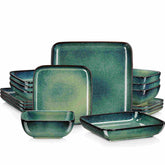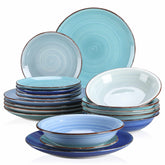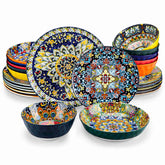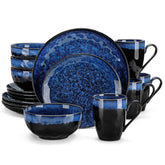The Artistry and Allure of Ceramic Dinnerware in Haute Cuisine
The clink of fine porcelain, the rustic texture of stoneware, the comforting warmth of an earthenware bowl - the ceramic vessels that cradle each course of a meal can elevate an already exquisite dining experience to new heights of sophistication. In the world of haute cuisine, ceramic dinnerware plays a starring role in creating singular sensory encounters that engage all the senses. Beyond just serving as utilitarian containers, the ceramics used in many Michelin-starred establishments and upscale restaurants make an artistic statement that helps to define each venue's identity. By analyzing the nuanced impact ceramic wares have on the aesthetics, ergonomics, and overall perception of high-end dining, it becomes clear why chefs and restaurateurs pay such close attention to the plates, bowls, and cups on their tables.
The Most Coveted Ceramics: Bespoke Michelin Porcelain
To earn the coveted Michelin stars that signify the pinnacle of fine dining, everything must be exceptional - including the dinnerware. It comes as no surprise then that Michelin-approved restaurants often collaborate with premier French porcelain makers such as Bernardaud or Raynaud to commission entirely custom designed and produced ceramic collections. For Thomas Keller's renowned restaurant The French Laundry, Bernardaud created a minimalist, straight-sided plate specifically shaped and sized to harmonize with Keller's culinary compositions. Meanwhile, the plates used at Alain Ducasse's Le Louis XV restaurant bear ornate hand-painted flowers and sea creatures that reflect the Riviera setting. By utilizing one-of-a-kind porcelain pieces only found at their venues, these taste-making chefs create a truly individualized and memorable dining experience from start to finish.
Beyond Porcelain - Pottery, Stoneware, and Earthenware
While porcelain remains a fine dining favorite due to its delicacy and refined aura, some top chefs opt for dinnerware with a more rustic, hand-thrown appeal. Noma in Copenhagen, frequently lauded as the world's best restaurant, uses rough-hewn stoneware and earthenware pottery crafted by local Danish ceramicists. The imperfections and idiosyncrasies of the mottled glazes and organc shapes complement Noma's locavore ethos and seasonal ever-changing menu. Meanwhile, Peter Gilmore's Quay restaurant in Australia takes great pride in serving each small-portioned course on custom pottery made nearby in the Kangaroo Valley. This textured handmade ware helps convey Quay's identity as a distinctly Australian fine dining experience. For these chef and restaurants, ceramics with an artisanal, irregular aesthetic add warmth, character, and a connection to place that sleek, refined porcelain cannot provide.
The Sensory Impact of Ceramic Dinnerware
Beyond just looks, the ceramic wares used in fine dining also influence the tactile, acoustic, and even taste sensations that comprise a diner's experience. A thick, heavy ceramic plate that gently clinks against cutlery offers a vastly different feel from tissue-thin bone china that barely muffles the clank of metal on porcelain. Both have merits, but provoke diners' senses differently. The acoustic properties also change when utensils scrape across lightly glazed vs heavily glazed surfaces. Some chefs insist that highly fired, unglazed "naked" porcelain accentuates certain flavors and textures compared to their glazed counterparts. And of course, the heat retention of thick, heavy stoneware means serving soups and stews in these rustic vessels enhances enjoyment by keeping each bite piping hot throughout the meal. With so many tactile variables, restaurants carefully curate ceramics that make food and drink taste and feel the way their chef intends.
The Art of Table Setting and Composition
Beyond the plates themselves, the overall styling of a dining table allows restaurants to make artistic statements and showcase whimsical creativity with their ceramic ware. Chefs like Michel Bras at his three-Michelin-star restaurant in France are known almost as much for the fanciful tablescapes spilling over with custom ceramics as for the food itself. Stacked groupings of plates on top of bowls and platters scattered across the table help diners focus on each individual piece as a unique art object. Elaborate, multi-part place settings with customized plates for bread, entrées, salad, dessert, and more also direct attention to the specificity of the ceramic wares. While excessive for some restaurants, this playful approach from Bras and others recognizes and highlights dinnerware's starring role in completing a fine dining atmosphere.
Elevating Dining Beyond Michelin to Everyday Luxury
Of course, one need not earn Michelin stars to appreciate and elevate a meal with ceramic artistry. Heirloom-quality handmade wares from local pottery studios can bring sophistication and charm to neighborhood bistros seeking to provide diners with an everyday luxury experience. In fact, incorporating hyper-local pottery or porcelain can allow restaurants to take an active role in supporting their own distinctive local arts community - and giving guests a taste of a city or town's creative spirit. With small-scale specialty makers expanding the limits of glazes, firing techniques, and shapes, there's an untapped world of ceramic artistry waiting to grace tables if chefs have the vision to support fellow artisans in their vicinity.
Similarly, family-owned restaurants can imbue service with a personal touch by using ceramic pieces passed down and collected through generations. Mixing vintage serving bowls and dinner plates to create a kaleidoscope of patterns characterized by a well-worn warm patina tells a restaurant's history at a glance. Chip-resistant modern porcelain then isn't always better. In fact, the odd nick and mark on an old hand-thrown bowl whispers of grandma's kitchen and a heritage of nurturing meals, not haute cuisine. With imagination and care, restaurants have the power to transform ceramics into conduits of nostalgia, comfort, and meaning.
The Next Course in Ceramic Couture
As more chefs recognize ceramic wares' starring role on the table, what dazzling new directions might fine dining ceramics take in the future? Perhaps we'll see hyper-modern, avant-garde forms echoing sculptural works traditionally confined to museum pedestals. Or designers may continue looking to the past, unearthing and reviving ornate decorative styles from Limoges, Wedgwood, or Ming Dynasty-era kilns. There are also radical new glaze formulas yet untapped, with luminescent qualities akin to Afrofuturist ceramics made for an intergalactic clientele. Ultimately the possibilities to reshape and reinvent dining's material culture are limitless, needing only chefs' imagination to unleash ceramicists' unrestrained creativity. Each unique plate, saucer, or bowl glazed, fired, and placed with intention has the power to thrill, comfort and engage.
So beyond its utilitarian purpose, we must view fine dining ceramic ware as edible art that activates all the senses while gracing tables - even just for the brief time before being stained by sauces. With such potential for emotional impact and sensory transformative power, it's clear why for many chefs and diners, the plates matter just as much as the food itself.












